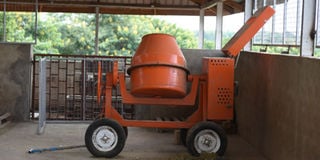Concrete mixer a must for dairy and beef farmers

Concrete mixer at Titus Kasujja’s farm in Luweero District. Photo by Ismael Kezaala
Mixing your own animal feeds at the farm is a very desirable activity, according to specialists.
Titus Kasujja, who operates a 400-acre dairy farm in Zirobwe, insists that when you mix your own feeds, you are able to determine the quality needed by the animals.
Gone are the days of braving the sweltering heat manually mixing homemade feeds with a shovel.
“Since most farmers do not do it themselves, few of the employees are committed to their job. Secondly, you can never be sure of the effectiveness of the mixture,” he says.
At his farm, he employs a concrete mixer which he says is efficient with a high productivity.
Kasujja uses a powerful machine he obtained locally and operated by two people. One feeds the materials, while another collects the ready products.
How to get the best
of your concrete mixer
Prepare the site
Before anything else, the first thing you should do is to prepare and prime the worksite for pouring. Apollo Kasangaki of AK Dairy farm in Nakasongola District advises that anyone using the mixer should mark the area and cordon it off.
“Safety is important and visitors nearby must wear safety gear. If your animals feed on contaminated food you are bound to lose a lot,” he says from the experience of once losing more than 100 cows when visitors who did not have safety wear visited his farm.
Wear proper
safety equipment
Kasujja who has more than 1000 dairy cows stresses that workers should put on personal protective gear. He says disposable protective gear for visitors is available in vet shops cheaply although he imports his from Denmark. But for the workers, he uses basic safety gear including dust masks, gloves, gowns and basic tools.
Keep it nearby
Since feeds can be heavy, all materials should be worked on as near the worksite as possible. Shorter travel times means easier transport, more trips in a shorter time, and less fatigue from the heavy load.
Inspect frequently
Check the mixer’s many components before it is turned on, during operation, and when it is shut down. Make sure the mixer blades are not bent. A quick inspection might save you a lot of wasted time and money down the line.
Level ground
Position the mixer on a stable, level surface, and never on damp or wet ground. Even if surface is secure, make it a point to place a stiff hardboard or something similar under the mixer for added security.
Regular maintenance
He advises on thoroughly cleaning the mixer immediately after use which he says is safe and inexpensive. For other works he recommends the use of professionals. He discards the thought of taking such tools as exceedingly sturdy and unbreakable. According to Kasujja each mixer will cost a farmer about Shs20m.
Simple dairy meal
Grind the whole maize together with cob into gritted form. Wilt the calliandra in a shade (not in direct sunlight) and grind it too. Mix all the ingredients thoroughly preferably using a drum mixer or even a spade and feed the cows. You can increase the quantity of the above ingredients depending on the number of animals you feed. To determine how much dairy meal each cow should get, you need to know how much milk each cow produces in a day; a cow should get at least one kilogramme of concentrate for every 1.5 litres it produces above seven litres of milk; for example, if your cow produces 10 litres of milk in a day, this means that it has produced an extra three litres of milk above the seven litres.
To know how much concentrate the cow should get, divide three litres by 1.5 thus 3litre ÷ 1.5litres = two kilogrammes, so the cow should be given two kilogramme of concentrate. Feed this in two portions a day.




